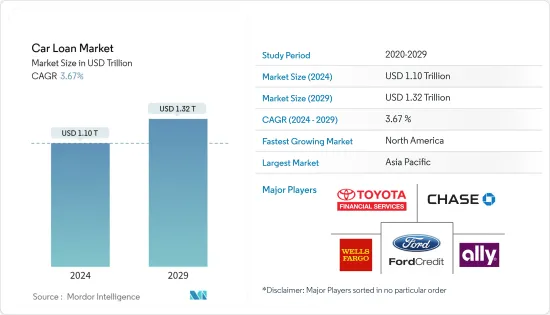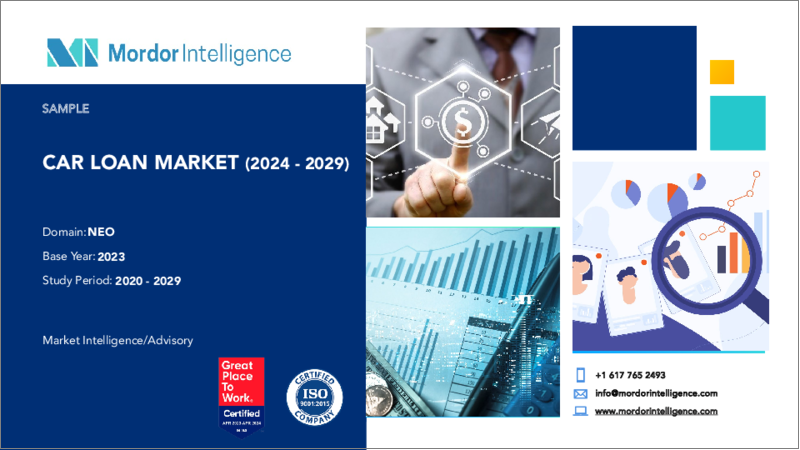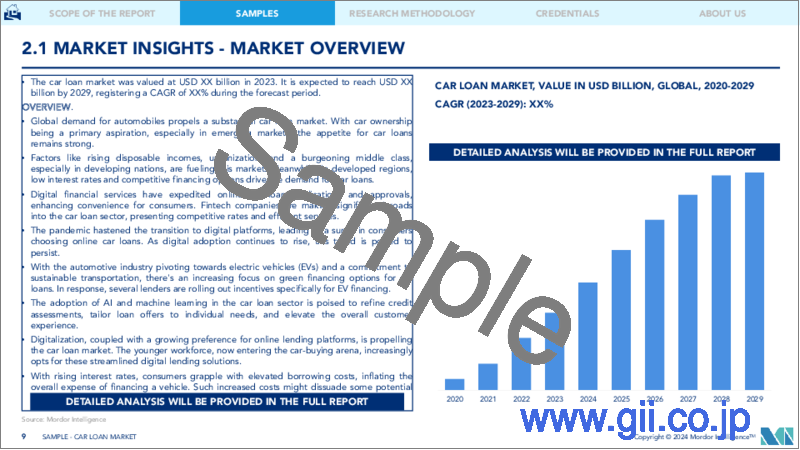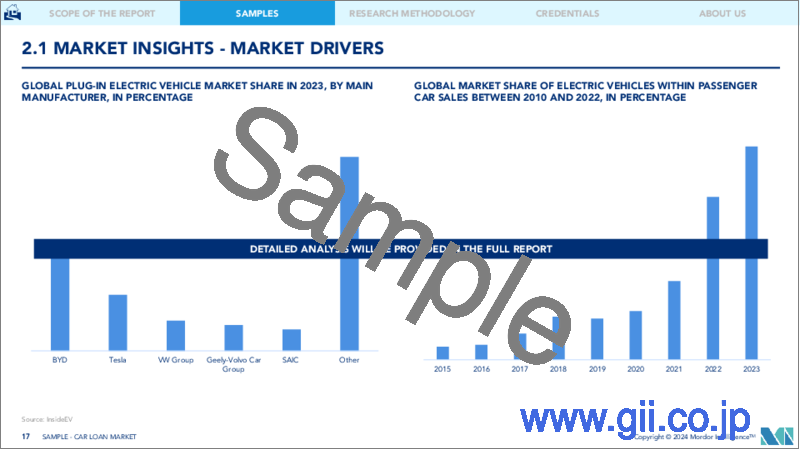|
|
市場調査レポート
商品コード
1521458
自動車ローン-市場シェア分析、産業動向・統計、成長予測(2024年~2029年)Car Loan - Market Share Analysis, Industry Trends & Statistics, Growth Forecasts (2024 - 2029) |
||||||
カスタマイズ可能
適宜更新あり
|
|||||||
| 自動車ローン-市場シェア分析、産業動向・統計、成長予測(2024年~2029年) |
|
出版日: 2024年07月15日
発行: Mordor Intelligence
ページ情報: 英文 120 Pages
納期: 2~3営業日
|
- 全表示
- 概要
- 目次
自動車ローン市場規模は2024年に1兆1,000億米ドルと推定・予測され、2029年には1兆3,200億米ドルに達し、予測期間(2024~2029年)のCAGRは3.67%で成長すると予測されます。

自動車ローン市場の規模は大きく、近年著しい成長を遂げています。経済状況、金利、消費者の嗜好などの要因に影響されます。市場全体の規模は地域によって影響を受け、新興経済諸国では一般的に自動車ローン市場が大きいです。自動車ローンは、銀行、信用組合、非銀行金融会社(NBFC)、オンライン金融業者など、さまざまな金融機関によって提供されています。伝統的な銀行が自動車ローン市場の支配的な参入企業でした。しかし、近年はオンライン金融業者やフィンテック企業が、競合ローン商品や合理化された申請プロセスを提供し、人気を集めています。自動車ローンの金利は、借り手の信用度、ローン期間、市場の実勢などの要因によって異なります。低金利は自動車ローンの需要を喚起し、購入しやすい価格にして消費者の購入資金調達を促します。自動車ローンは通常、返済期間が固定されており、36ヵ月から72ヵ月が一般的です。
COVID-19後のシナリオでは、自動車ローン市場は回復基調にあります。経済が回復を続ける中、自動車ローンに対する需要が増加しています。この背景には、旺盛な需要、低金利、金融機関が提供する有利な融資オプションなどがあります。市場は今後数年間はプラス成長を示すと予想され、自動車産業が有望な展望であることを示しています。
自動車ローン市場の動向
アジアにおける乗用車販売の増加
アジアにおける乗用車販売の増加は、同地域の自動車ローン市場に直接的な影響を与えています。欧州は世界の乗用車販売台数の20%を占め、アジア(52%)、南北アメリカ(24%)に次ぐ第3位です。中国ブランドの乗用車販売台数は2023年第1~3四半期に前年同期比21.2%増の990万台近くに急増しました。インドは2022年に日本を抜いて中国、米国に次ぐ第3位の自動車市場となり、乗用車と商用車を合わせて425万台以上を販売します。アジアにおける乗用車販売の増加は、銀行や自動車ローン専門業者を含む金融機関の競争激化につながっています。成長する市場でシェアを獲得するため、これらの金融機関は競合金利、柔軟な返済条件、魅力的なローン・パッケージを提供しています。このような競争は、消費者に幅広い選択肢と有利なローン条件を提供することで利益をもたらしています。
中古車販売の増加
中古車販売の増加にはいくつかの要因があります。まず、手頃な価格が大きな役割を果たしています。中古車は一般的に、新車に比べて予算に優しいため、人々はお金をかけずに移動のニーズを満たすことができます。さらに、中古車市場には幅広い選択肢があるため、購入者はさまざまなメーカー、モデル、製造年から選ぶことができます。中古車を購入するもう一つの利点は、減価償却費が低いことです。新車は最初の数年でその価値のかなりの部分が失われる傾向があるが、中古車はすでに減価償却の大部分を終えています。つまり、購入者は中古車を購入することで、よりお得な買い物ができる可能性があるのです。さらに、オンライン市場や専用プラットフォームの成長により、インドでは中古車の売買がかつてないほど容易になっています。これらのプラットフォームは、売り手にとってはより多くの人々にリーチできる便利な方法であり、買い手にとっては自宅に居ながらにして幅広い品揃えの車を閲覧できる便利な方法です。
自動車ローン業界概要
自動車ローン市場は適度にセグメント化されています。現在、Toyota Financial Services、Ford Credit、Ally Financial、Chase Auto Finance、Wells Fargo Autoなどの大手企業が市場を独占しています。自動車ローン市場は多様で、様々な金融機関や貸金業者が消費者に様々なローン商品を提供しています。競合は、オンライン・ローン・プラットフォーム、テレマティクス・ベースのローン商品、環境に優しい自動車に合わせたオプションなど、市場の革新を推進してきました。
その他の特典:
- エクセル形式の市場予測(ME)シート
- 3ヶ月間のアナリストサポート
目次
第1章 イントロダクション
- 調査の前提条件と市場定義
- 調査範囲
第2章 調査手法
第3章 エグゼクティブ概要
第4章 市場力学と洞察
- 市場概要
- 市場促進要因
- 高級車需要の増加が市場成長を促進
- 市場抑制要因
- 自動車ローン金利の上昇が市場を抑制
- 市場機会
- 電気自動車(EV)の人気の高まり
- 自動車メーカーと金融業者間の提携
- 業界の魅力-ポーターのファイブフォース分析
- 供給企業の交渉力
- 買い手の交渉力
- 新規参入業者の脅威
- 代替品の脅威
- 競争企業間の敵対関係
- 市場における技術革新洞察
- COVID-19の市場への影響
第5章 市場セグメンテーション
- 製品タイプ別
- 乗用車
- 商用車
- 所有者別
- 新車
- 中古車
- 業者タイプ別
- 銀行
- 銀行以外の金融サービス
- 自動車メーカー
- その他(Fintech企業)
- 勤続年数別
- 3年以下
- 3~5年
- 5年以上
- 地域別
- 北米
- 米国
- カナダ
- その他の北米
- 欧州
- 英国
- ドイツ
- その他の欧州
- アジア太平洋
- 中国
- 韓国
- その他のアジア太平洋
- ラテンアメリカ
- ブラジル
- チリ
- その他のラテンアメリカ
- 中東・アフリカ
- アラブ首長国連邦
- サウジアラビア
- その他の中東・アフリカ
- 北米
第6章 競合情勢
- 市場集中概要
- 企業プロファイル
- Toyota Financial Services
- Ford Credit
- Ally Financial
- Chase Auto Finance
- Wells Fargo Auto
- Bank of America
- Capital One Auto Finance
- Santander Consumer
- BMW Financial Services
- Honda Financial Services*
第7章 市場動向
第8章 免責事項と出版社について
The Car Loan Market size is estimated at USD 1.10 trillion in 2024, and is expected to reach USD 1.32 trillion by 2029, growing at a CAGR of 3.67% during the forecast period (2024-2029).

The car loan market is substantial and has experienced significant growth in recent years. It is influenced by factors such as economic conditions, interest rates, and consumer preferences. The overall market size is influenced by regions, with developed economies generally having a larger car loan market. Car loans are provided by various financial institutions, including banks, credit unions, non-banking financial companies (NBFCs), and online lenders. Traditional banks have been dominant players in the car loan market. Still, online lenders and fintech companies have gained traction in recent years, offering competitive loan products and streamlined application processes. Interest rates for car loans vary depending on factors such as the borrower's creditworthiness, loan term, and prevailing market conditions. Low-interest rates can stimulate demand for car loans, making them more affordable and encouraging consumers to finance purchases. Car loans typically have fixed repayment periods, commonly ranging from 36 to 72 months.
The car loan market has been witnessing a rebound in the post-COVID-19 scenario. As economies continue to recover, there is an increased demand for vehicle financing. This can be attributed to factors such as pent-up demand, low-interest rates, and favorable financing options provided by lenders. The market is expected to show positive growth in the coming years, indicating a promising outlook for the automotive industry.
Car Loan Market Trends
Increasing Sales of Passenger Cars in Asia
The increasing sales of passenger cars in Asia have a direct impact on the car loan market in the region. Europe accounts for 20% of global passenger car sales, coming third after Asia (52%) and the Americas (24%). Chinese-brand passenger car sales surged 21.2 percent year on year in the first three quarters of 2023 to nearly 9.9 million units. India has beaten Japan to become the third largest vehicle market in 2022 after China and the US, selling more than 4.25 million vehicles, including passenger and commercial. The increasing sales of passenger cars in Asia are leading to intensified competition among financial institutions, including banks and specialized car loan providers. To capture a share of the growing market, these institutions are offering competitive interest rates, flexible repayment terms, and attractive loan packages. This competition benefits consumers by providing them with a range of options and favorable loan terms.
Increase in Sales of Used Cars
The increasing sales of used vehicles are attributed to several factors. Firstly, affordability plays a significant role. Used cars are generally more budget-friendly compared to brand-new ones, allowing people to fulfill their transportation needs without breaking the bank. Additionally, the wide range of options available in the used car market allows buyers to choose from various makes, models, and years of production. Another advantage of buying a used vehicle is the lower depreciation costs. New cars tend to lose a significant portion of their value in the first few years, whereas used cars have already undergone the majority of this depreciation. This means that buyers can potentially get more value for their money when purchasing a used vehicle. Furthermore, the growth of online marketplaces and dedicated platforms has made it easier than ever to buy and sell used vehicles in India. These platforms provide a convenient way for sellers to reach a larger audience and for buyers to browse through a wide selection of cars from the comfort of their own homes.
Car Loan Industry Overview
The market for car loans is moderately fragmented. Major players like Toyota Financial Services, Ford Credit, Ally Financial, Chase Auto Finance, and Wells Fargo Auto currently dominate the market. The car loan market is diverse, with various financial institutions and lenders offering a range of loan products to consumers. Competitive forces have driven innovations in the market, Such as online loan platforms, telematics-based loan products, and options tailored to eco-friendly vehicles.
Additional Benefits:
- The market estimate (ME) sheet in Excel format
- 3 months of analyst support
TABLE OF CONTENTS
1 INTRODUCTION
- 1.1 Study Assumptions and Market Definition
- 1.2 Scope of the Study
2 RESEARCH METHODOLOGY
3 EXECUTIVE SUMMARY
4 MARKET DYNAMICS AND INSIGHTS
- 4.1 Market Overview
- 4.2 Market Drivers
- 4.2.1 Rise in Demand for Luxury Cars Fueling the Market Growth
- 4.3 Market Restraints
- 4.3.1 Increase in Car Loan Interest Rates is Restraining the Market
- 4.4 Market Opportunities
- 4.4.1 Increasing Popularity of Electric Vehicles (EVs)
- 4.4.2 Collaborations Between Car Manufacturers and Lenders
- 4.5 Industry Attractiveness - Porter's Five Forces Analysis
- 4.5.1 Bargaining Power of Suppliers
- 4.5.2 Bargaining Power of Buyers
- 4.5.3 Threat of New Entrants
- 4.5.4 Threat of Substitutes
- 4.5.5 Intensity of Competitive Rivalry
- 4.6 Insights of Technology Innovations in the Market
- 4.7 Impact of COVID-19 on the Market
5 MARKET SEGMENTATION
- 5.1 By Product Type
- 5.1.1 Passenger Vehicle
- 5.1.2 Commercial Vehicle
- 5.2 By Ownership
- 5.2.1 New Vehicles
- 5.2.2 Used Vehicles
- 5.3 By Provider Type
- 5.3.1 Banks
- 5.3.2 Non-Banking Financial Services
- 5.3.3 Original Equipment Manufacturers
- 5.3.4 Other Provider Types (Fintech Companies)
- 5.4 By Tenure
- 5.4.1 Less Than Three Years
- 5.4.2 3-5 Years
- 5.4.3 More Than 5 Years
- 5.5 By Geography
- 5.5.1 North America
- 5.5.1.1 United States
- 5.5.1.2 Canada
- 5.5.1.3 Rest of North America
- 5.5.2 Europe
- 5.5.2.1 United Kingdom
- 5.5.2.2 Germany
- 5.5.2.3 Rest of Europe
- 5.5.3 Asia-Pacific
- 5.5.3.1 China
- 5.5.3.2 South Korea
- 5.5.3.3 Rest of Asia-Pacific
- 5.5.4 Latin America
- 5.5.4.1 Brazil
- 5.5.4.2 Chile
- 5.5.4.3 Rest of Latin America
- 5.5.5 Middle East and Africa
- 5.5.6 UAE
- 5.5.7 Saudi Arabia
- 5.5.8 Rest of Middle East and Africa
- 5.5.1 North America
6 COMPETITIVE LANDSCAPE
- 6.1 Market Concentration Overview
- 6.2 Company Profiles
- 6.2.1 Toyota Financial Services
- 6.2.2 Ford Credit
- 6.2.3 Ally Financial
- 6.2.4 Chase Auto Finance
- 6.2.5 Wells Fargo Auto
- 6.2.6 Bank of America
- 6.2.7 Capital One Auto Finance
- 6.2.8 Santander Consumer
- 6.2.9 BMW Financial Services
- 6.2.10 Honda Financial Services*






